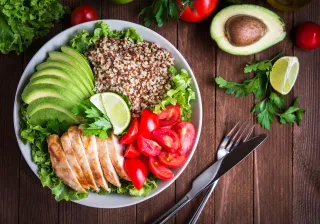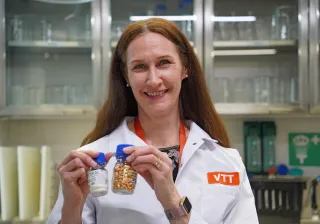Cellular agriculture has the potential to become one of the drivers of Finland’s export. At the same time, it may provide us with the key to solve the global food and climate crisis. However, EU legislation stands in the way of the development of the industry and the introduction of new innovations.
Cellular agriculture refers to the utilisation of cell culture techniques in food production. Animal and plant cells, microbes or algae are grown in steel tanks to produce ingredients for the food industry, which can replace ingredients produced by traditional agricultural means.
According to Emilia Nordlund, Research Manager at the VTT Technical Research Centre of Finland, cellular agriculture can be divided into two categories. Both technologies afford the opportunity to develop countless applications.
“Cells can be either grown and used as such for food or designed to produce a specific nutrient, such as a fat or a protein. Quorn mycoprotein products found in freezers in grocery stores are examples of the first category, and additives used by the food industry, such as vitamins and enzymes, are existing examples of the latter,” Nordlund says.
The technology has a long history
The biotechnology behind cellular agriculture is not new. Additives have been produced using the same technology for decades, and yeast has been used for brewing beer for millennia. Products such as yogurts, soy sauces and kombuchas are also produced by fermentation, that is, with the help of microbes.
The PEKILO process developed in 1963–1975 is considered the pioneer of cellular agriculture. Scientists managed to successfully cultivate the Pekilo fungus isolated from Finnish soil in fermenters. The first mycoprotein production plant in continuous operation was established in Jämsänkoski in 1975. The process was used to produce sustainable feed protein from the side streams of the forest industry until the recession hit in 1991.
Finnish startup eniferBio Oy has modernised the process and is currently developing an end product for more valuable applications in animal and human nutrition. There should be no shortage of demand – the global need for protein is estimated to double by 2050. At the same time, the huge amount of emissions from the cultivation of soya and livestock farming must be cut.
“Environmental values and the welfare of farmed animals are increasingly reflected in consumers’ food choices, which increases interest in cellular agriculture products. Finland’s extensive investments in research and product development, capability to create food innovations and high-level expertise in biotechnology provide a good starting point for success in the industry. Challenging climate conditions prevent us from competing in agriculture with regions such as Central and Southern Europe, but when it comes to cellular agriculture, Finland is already leading the way,” says Simo Ellilä, CEO of eniferBio.
Pasi Vainikka, CEO of Solar Foods Oy, points out that Finnish companies can export not only food products, but also technology developed for cellular agriculture to the world. While the limited area of arable land constrains the export of traditional agriculture products, the export opportunities for technology are infinite. Solar Foods is a prime example of this. The company is currently investing EUR 40 million in the first plant where protein-rich microbial mass will be produced from carbon dioxide using electricity. This technology has the potential to become a significant export product in the future.
The article continues after the photo.
Cellular agriculture at its best: Pekilo powder and meatless meatballs made from it, Solein powder and dairy-free ice cream made from it and Onego Bio’s egg white powder and meringue made from it.

Cellular agriculture also supports traditional agriculture
Ellilä, Vainikka and Maija Itkonen, CEO of Onego Bio Ltd, believe that cellular agriculture is the answer to the global food crisis and environmental challenges. With the new production method, food products can be produced more efficiently, with lower emissions and closer to end-users. Thanks to these, cellular agriculture contributes to the creation of a sustainable and self-sufficient food system.
“Even in cellular agriculture, cell cultures need nutrients to grow. Compared to traditional agriculture, nutrients can be utilised more efficiently in cellular agriculture. For example, protein can be produced at least ten times more efficiently than in animal production,” Vainikka says.
Primary producers deserve fair compensation for their products
The CEOs of the companies specialising in cellular agriculture applications emphasise that technological development will not replace traditional agriculture.
“On the contrary, cellular agriculture provides traditional primary producers with the opportunity to receive a fairer compensation for their products. Agricultural entrepreneurs have a positive attitude towards cellular agriculture,” Ellilä says.
“Cellular agriculture provides an efficient and sustainable way to produce, for example, protein-rich ingredients for the food market, which reduces the pressure on livestock producers to produce more food at a cheaper price. In the future, livestock producers can focus on the most valuable products featured in traditional food culture without it compromising the security of supply. At the same time, the living conditions of farmed animals can be improved and the climate impact of food production reduced,” Itkonen says.
Itkonen’s company, Onego Bio, supplies the food industry with egg white produced by fermentation. According to Itkonen, the process is considerably more cost-effective that traditional egg production, as well as more eco- and animal-friendly.
The EIT FAN programme accelerates the growth of startups
When the PEKILO project died down in the 90s, cellular agriculture was facing quieter decades. The situation changed in the mid-2010s when the food industry woke up to enormous sustainability challenges. Around the same time, VTT combined two of its competence areas, food research and industrial biotechnology. The research quickly yielded results as experts who had previously been working for the benefit of different industries engaged in co-operation. The intersection of these industries generated innovations around which startup companies were established. For example, the processes of eniferBio, Onego Bio and Solar Foods are based on cross-disciplinary research conducted at VTT.
“Long-term investment in the research and development of cellular agriculture continues to be of critical importance to ensure the emergence of new innovations and Finland’s and EU’s competitiveness in the global market. This requires state support in the form of research and innovation funding, for example,” Nordlund says.
VTT plays a crucial role in accelerating cellular agriculture operations. Mirva Lampinen, Co-creation Manager at VTT, explains that the research organisation is leading the international EIT Food network’s FAN Helsinki Hub accelerator programme, which focuses on developing food system startups.
“The programme was previously aimed at all startups specialising in food and agricultural technology. Next year, we will focus on new food production methods, such as cellular agriculture. During the two-month programme, the participating startups receive guidance and support from VTT, the University of Helsinki and partner organisations,” Lampinen says.
Solar Foods and eniferBio, both of which are planning to expand to global markets, have also completed the EIT FAN. The companies’ CEOs say that the programme helped them in creating international business and investor networks, building a team and developing their product, among other things.
EU legislation as a hindrance
The development activities and marketing efforts of startups require plenty of capital. Itkonen, Vainikka and Ellilä know that Finnish cellular agriculture startups are appealing to international investors. The industry meets investors’ ESG criteria and technological solutions provide good opportunities for scaling business. In addition, Finland is known as a safe and reliable country.
The future of cellular agriculture looks promising. However, the sluggishness of EU legislation is a problem for companies. In the USA, for example, legislation is much more permissive.
“Most cellular agriculture products are novel foods, and selling and marketing them in the EU area requires the approval of the EU Commission. A novel food is a type of food that is produced by a new method or that hasn’t been used for human consumption to a significant degree in the EU before 1997. Obtaining a sales permit requires a safety assessment by the European Food Safety Authority EFSA, and it takes years,” says Pauliina Halimaa, CEO of Biosafe Oy.
Biosafe helps cellular agriculture companies in international permit processes, supports product launches and carries out product examinations required by the assessment authorities. In addition, Biosafe promotes the amendment of legislation to be more favourable to cellular agriculture as part of the biotechnology industry association EuropaBio.
“There’s an urgent need for changes to legislation. For example, the EU’s Transparency Regulation 2019/1381 has increased bureaucracy and the time required for the permit process, and the introduction of new technologies has rendered legislation on genetically modified organisms obsolete. The actions of authorities should also be more transparent and predictable. In order for the EU to compete against China and the USA in the international agricultural transformation, I expect our MEPs and Members of Parliament to take action to change EU legislation. Laws should support innovations that can save the world,” Halimaa says.
A way to feed the ever-growing population
- Cellular agriculture complements traditional food production with an effective solution for feeding the growing population.
- In cellular agriculture, ingredients are produced by cultivating, for example, microbes or animal cells in bioreactors.
- The method can be used to produce ingredients such as animal-based proteins and fats as a substitute for meat counterparts.
- Existing examples of foods produced using the method are Quorn made from the biomass of a mold fungus and microalgae sold as food supplements.
- Cellular agriculture is also a safe method to produce food as harmful substances cannot enter the closed system through the soil and antibiotics are not needed in production.
Text: Tuomas I. Lehtonen Photos: Patrik Pesonen
Simo Ellilä, Pauliina Halimaa, Pasi Vainikka, Maija Itkonen, Mirva Lampinen and Emilia Nordlund work with cellular agriculture.







